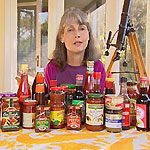These days there are many different sauces, curry pastes and pestos available, as well as the two old favourites, tomato and Worcestershire sauce. In our segment Dr. Rosemary Stanton looked at sauces, why they are so popular and whether they can be part of a healthy diet.
Why use sauces?
Sauces are mostly added for flavour, but they also moisten food and make it easier to swallow. It is possible that people are using sauces more because some foods, such as chicken and meat, have less flavour than they once did. People are also eating more rice and pasta, which are bland and call for highly flavoured sauces.
Problem ingredients
Salt: The major problem ingredient in most sauces is salt. About 3 million Australians have high blood pressure, partly due to excess weight but also from eating too much salt.
Babies don’t like salt, but their taste buds soon become used to it. Once you develop the salt habit, you’re likely to crave salty foods. Some children become hooked on tomato sauce and pour it over almost everything. Rosemary suggested that you don’t start little kids off on tomato sauce, so their tastebuds can explore the natural flavours in foods before they become ruined by salt.
Sauces such as soy, oyster, black bean and fish are very salty. Soy sauce has about six times as much salt as tomato sauce. There are low-salt soy sauces available, but they still contain a lot of salt. The amount of salt in chilli sauces varies, but few people use chilli sauce in large quantities so this is not a problem. Some curry pastes have no added salt – their flavour comes from spices and herbs. Check the ingredient list, keeping in mind that ingredients are listed in their order of prominence with major ingredients listed first.
Fat: Most bought sauces, apart from hollandaise, are not high in fat. Some curry pastes are very oily, but it is ‘good’ unsaturated oil and the small quantity used will not cause problems. Pesto also contains unsaturated vegetable oil, but when added to pasta (which is very low in fat) the total fat content of the meal is not too high. Vegetable-based pasta sauces are a better choice than creamy ones.
Sugar: Some sauces, such as tomato and chilli, contain a lot of sugar.
What to do
Don’t start little kids off on tomato sauce, so their tastebuds will be able to explore the natural flavours in foods. When tomatoes are cheap, make your own tomato sauce (see recipe below). Check the labels and buy sauces that don’t have too many additives. From the end of this year, the sodium content will be included on all food labels. This means that if you are watching your salt intake, you’ll be able to compare products and make the best choice.
Fresh tomato sauce
Make double quantities of this sauce when tomatoes are cheap and flavoursome. It freezes well and is ideal to use with pasta or in lasagne. 1 tbsp olive oil, 1 large onion, chopped, 2 cloves garlic, crushed, 1 tsp dried thyme leaves, 1 kg fresh tomatoes, skinned and diced, 1 tsp sugar, 1/2 cup white wine, 4 bay leaves, 2 tbsp tomato paste
Heat olive oil in a wok, saucepan or frying pan and add onion, garlic and thyme. Cover and allow onion to sweat for 5 minutes, stirring occasionally. Add tomatoes, sugar, wine and bay leaves and cook over a medium heat for 10 minutes. Remove bay leaves and stir in tomato paste. Puree to give a smooth tomato sauce.
Serves 4



